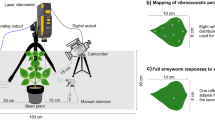Abstract
Leaf-borne vibrations are potentially important to caterpillars for communication and risk assessment. Yet, little is known about the vibratory environment of caterpillars, or how they detect and discriminate between vibrations from relevant and non-relevant sources. We measured the vibratory ‘landscape’ of the territorial masked birch caterpillar Drepana arcuata (Drepanidae), and assessed its ability to detect and respond to vibrations generated by conspecific and predatory intruders, wind and rain. Residents of leaf shelters were shown to respond to low amplitude vibrations generated by a crawling conspecific intruder, since removal of the vibrations through leaf incision prevented the resident’s response. Residents did not respond to large amplitude, low frequency disturbances caused by wind and rain alone, but did respond to approaching conspecifics under windy conditions, indicating an ability to discriminate between these sources. Residents also responded differently in the presence of vibrations generated by approaching predators (Podisus) and conspecifics. An analysis of vibration characteristics suggests that despite significant overlap between vibrations from different sources, there are differences in frequency and amplitude characteristics that caterpillars may use to discriminate between sources. Caterpillars live in a vibration-rich environment that we argue forms a prominent part of the sensory world of substrate bound holometabolous larvae.










Similar content being viewed by others
References
Barth FG (1997) Vibratory communication in spiders: Adaptation and compromise at many levels. In: Lehrer M (ed) Orientation and communication in arthropods. Birkhäuser Verlag, Basel (Switzerland), pp 247–272
Barth FG, Bleckmann H, Bohnenberger J, Seyfarth EA (1988) Spiders of the genus Cupiennius Simon 1891 (Araneae, Ctenidae). II. On the vibratory environment of a wandering spider. Oecologia 77:194–201
Bennet-Clark HG (1998) Size and scale effects as constraints in insect sound communication. Phil Trans R Soc Lond B 353:407–419
Caldwell MS, McKaniel JG, Warkentin KM (2009) Frequency information in the vibration-cued escape hatching of red-eyed treefrogs. J Exp Biol 212:566–575
Casas J, Bacher S, Tautz J, Meyhöfer R, Peirre D (1998) Leaf vibrations and air movements in a leafminer-parasitoid system. Biol Control 11:147–153
Castellanos I, Barbosa P (2006) Evaluation of predation risk by a caterpillar using substrate-borne vibrations. Anim Behav 72:461–469
Cocroft RB, Rodríguez RL (2005) The behavioral ecology of insect vibrational communication. Bioscience 55:323–334
Fletcher LE, Yack JE, Fitzgerald TD, Hoy RR (2006) Vibrational communication in the cherry leaf roller caterpillar Caloptilia serotinella (Gracillarioidea: Gracillariidae). J Insect Behav 19:1–18
Greenfield MD (2002) Signalers and receivers: mechanisms and evolution. Oxford University, New York
Hasenfuss I (1993) Morphology, evolution, and taxonomic importance of supposed web-vibration receptors in the larvae of butterflies (Lepidoptera: Pyraloidea, Gelechioidea). Entomol Gener 18:43–54
Hess WN (1917) The chordotonal organs and pleural discs of cerambycid larvae. Ann Ent Soc Am 10:63–78
Hill PSM (2008) Vibrational communication in animals. Harvard University Press, Cambridge
Ishay J, Motro A, Gitter S, Brown MB (1974) Rhythms in acoustical communication by the oriental hornet, Vespa orientalis. Anim Behav 22:741–744
McNett GD, Luan LH, Cocroft RB (2010) Wind-induced noise alters signaler and receiver behavior in vibrational communication. Behav Ecol Sociobiol 64:2043–2051
Meurgey F, Faucheux MJ (2006) Vibroreceptors and proprioceptors on the larval antennae of Erythromma lindenii (Sélys) (Zygoptera: Coenagrionidae). Odonatologica 35:255–264
Pfannenstiel RS, Hunt RE, Yeargan KV (1995) Orientation of a hemipteran predator to vibrations produced by feeding caterpillars. J Insect Behav 8:1–9
Saliba LJ (1972) Gallery orientation in cerambycid larvae. The Entomologist 105:300–304
SAS Institute (2002) SAS user’s manual, version 9.1. SAS Institute, Cary
Scott JL, Kawahara AY, Skevington JH, Yen S, Sami A, Smith ML, Yack JE (2010) The evolutionary origins of ritualized acoustic signals in caterpillars. Nature Commun 1:4
Sokal RR, Rohlf FJ (1995) Biometry, 3rd edn. WH Freeman, New York
Travassos MA, Pierce NE (2000) Acoustics, context and function of vibrational signaling in a lycaenid butterfly–ant mutualism. Anim Behav 60:13–26
Virant-Doberlet M, Čokl A (2004) Vibrational communication in insects. Neotrop Entomol 33:121–134
Warkentin KM (2005) How do embryos assess risk? Vibrational cues in predator-induced hatching of red-eyed treefrogs. Anim Behav 70:59–71
Yack JE, Smith ML, Weatherhead PJ (2001) Caterpillar talk: acoustically mediated territoriality in larval Lepidoptera. Proc Natl Acad Sci USA 98:11371–11375
Acknowledgments
We are grateful to the Queen’s University Biology Station for giving us permission to use their facilities for collecting moths, to Karen Wang and Jaclyn Bowen for artwork contributions, and to two anonymous reviewers for extremely helpful comments on an earlier version of this manuscript. This research was funded by the Natural Science and Engineering Council of Canada (JEY), the Canadian Foundation for Innovation and the Ontario Trust Fund (JEY), and the National Council of Scientific and Technological Development of Brazil (RNCG).
Author information
Authors and Affiliations
Corresponding author
Electronic supplementary material
Below is the link to the electronic supplementary material.
Supplementary material 1 (MP4 4745 kb)
Rights and permissions
About this article
Cite this article
Guedes, R.N.C., Matheson, S.M., Frei, B. et al. Vibration detection and discrimination in the masked birch caterpillar (Drepana arcuata). J Comp Physiol A 198, 325–335 (2012). https://doi.org/10.1007/s00359-012-0711-8
Received:
Revised:
Accepted:
Published:
Issue Date:
DOI: https://doi.org/10.1007/s00359-012-0711-8




